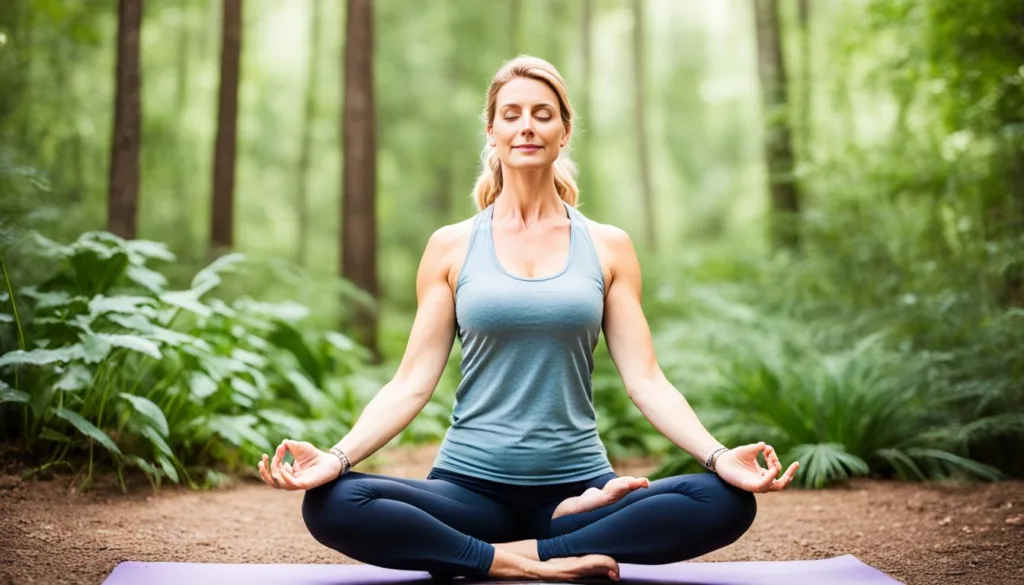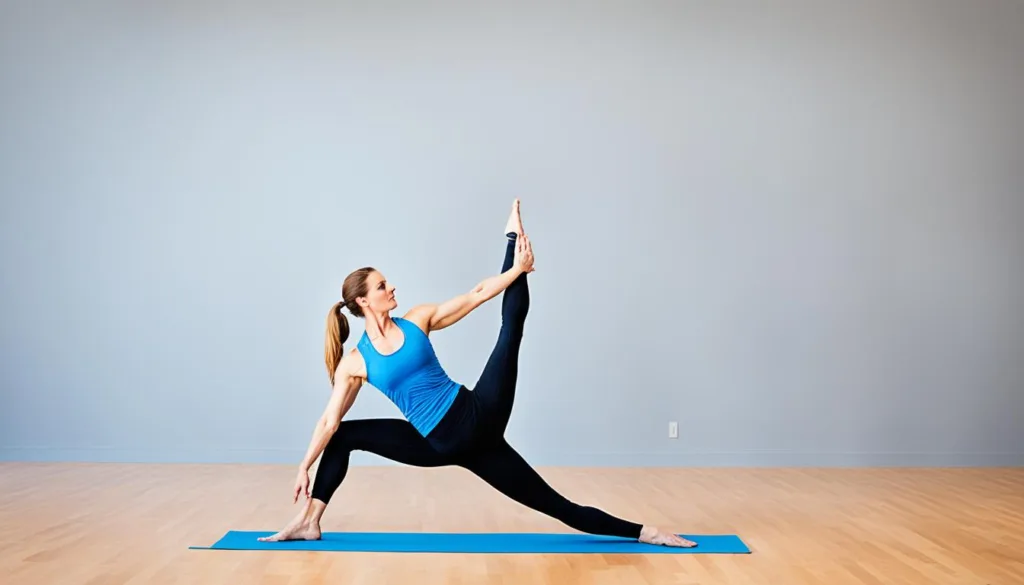Advantages and Disadvantages of Yoga You Should Know
With more than 300 million yoga practitioners globally, the reach of this ancient discipline is vast and growing. Amongst these millions, enthusiasts and skeptics alike grapple with the advantages and disadvantages of yoga. Whether you’re looking to start a new fitness regime or ponder the pros and cons of yoga, understanding its benefits and drawbacks is pivotal for your wellness journey.
Yoga is hailed for enhancing flexibility, promoting stress relief, and offering a pathway to spiritual connection, but it’s not a one-size-fits-all remedy. As you consider folding yoga into your life, it’s crucial to weigh both the positive effects and potential risks, to make an informed decision that aligns with your personal health and wellness goals.
Key Takeaways
- Yoga’s global popularity underscores its appeal as a practice with myriad health benefits.
- Understanding the full spectrum of yoga’s effects, including both advantages and disadvantages, is crucial for practitioners.
- Consider both the pros and cons of yoga when incorporating it into your wellness regimen.
- An informed approach to yoga can accentuate benefits and mitigate potential negatives for a harmonious wellness journey.
- Individual health goals and conditions dictate the suitability and potential risks of various yoga practices.
Exploring the Ancient Practice of Yoga
Embark on a journey through time as we delve into the origins and significance of an ancient practice that has spanned millennia. Yoga is more than just a series of postures; it’s a pathway to greater wellness and understanding of the interconnectedness of mind, body, and spirit. Through the evolution of Yoga, you’ll see how it has emerged as a holistic approach to health, transcending its historical roots and assimilating into modern life.
The Origins and Evolution of Yoga
The tapestry of yoga is rich with history, originating over 5,000 years ago in India. What began as a meditative practice has transformed through time, integrating various methodologies to support the harmonious development of the individual. At the heart of its evolution is the sage Patanjali, whose ancient texts laid the groundwork for what yoga is today. As the years passed, the ancient practice of yoga adapted, yet maintained its essence as a profound means for personal and spiritual growth.
The Philosophical and Spiritual Significance of Yoga
At its core, yoga is a quest for unity—a fusion connecting the individual self with the greater universal consciousness. The philosophical and spiritual undercurrents of yoga give credence to its power as more than just exercise. It invites practitioners to engage in a deeper exploration of their existence and place within the cosmos, promoting a sense of balance and peace that permeates all aspects of life.
Yoga as a Holistic Approach to Wellness
Today, yoga stands as an emblem of a holistic approach to wellness. It encourages not only physical activity but also mental clarity and emotional resilience. Recognizing that true health spans the full spectrum of human experience, yoga offers tools for self-improvement that resonate on all levels—enhancing stamina, improving focus, and fostering tranquility.
As we reflect on the evolution of Yoga, a chronology chart helps to illustrate its growth and adaptation over the centuries:
| Period | Development | Impact |
|---|---|---|
| Pre-Vedic India | Beginnings of meditative practices | Foundation for later yogic principles |
| Classical Period | Patanjali’s Yoga Sutras | Standardization of yoga philosophy and practice |
| Medieval Period | Rise of devotional yoga (Bhakti) | Integration of emotional and spiritual aspects |
| Modern Period | Global dissemination of yoga | Adaptation and innovation in practice |
In embracing the ancient practice of yoga, you unlock a legacy that has guided countless individuals toward well-being and self-discovery. The timeless wisdom embodied in yoga continues to inspire and evolve, ensuring its relevance for generations to come. Stand upon the shoulders of sages and embrace the transformative power of yoga in your own journey toward holistic well-being.
The Health Benefits of Regular Yoga Practice
Yoga is more than a series of poses and deep breathing. Through persistent practice, the health benefits of yoga can transform your physical condition, mental state, and contribute to your internal wellness. Whether you’re looking to boost your flexibility or find inner peace, yoga could be the key to enhancing your overall health.
Physical Advantages: Flexibility, Strength, and Posture
Incorporating yoga into your daily routine can lead to vast physical advantages. As you flow through various postures, you’re not just improving flexibility — you’re also building muscle strength and correcting your posture. Benefits include relief from back pain, a stronger core, and the possibility of a more poised stance in your everyday life.
- Increased Flexibility – Reach further, bend better, and say goodbye to stiffness.
- Greater Strength – Build muscle endurance with poses that target various muscle groups.
- Improved Posture – Stand taller and combat the slouch with alignment-focused asanas.
Mental Health: Stress Reduction and Enhanced Focus
One of the great wonders of yoga is its capacity for enhancing mental health. Stress relief isn’t just a passing benefit; it’s a profound transformation that occurs with consistent practice. Yoga provides a space for mindfulness, where you can learn to silence the noise and enhance your focus in a world filled with distractions.
Regular yoga practice calms the mind and paves the way for improved concentration and mental clarity.
Internal Wellness: Improved Organ Function and Detoxification
Beyond the mind and external body, yoga extends its reach to your internal wellness. Certain poses massage and stimulate your internal organs, encouraging better organ function and detoxification. This internal attention can stimulate your digestive system, improve your immune response, and even reduce the risk of chronic diseases.
The true beauty of yoga lies in its accessibility; regardless of age, you can modify poses to benefit your unique physical situation. With yoga, you are always in control, facilitating healing and recovery that align with your body’s needs.

As you continue to explore the wonders of yoga, keep in mind these comprehensive benefits that cater to various aspects of your life. Whether it’s to recover, maintain, or improve, the ancient wisdom of yoga has a place in your journey towards a healthier self.
Advantages and Disadvantages of Yoga
Yoga, an enriching practice with origins steeped in ancient history, presents many merits and demerits that you should be aware of before stepping onto the mat. As a practitioner, understanding the positive and negative aspects of yoga is crucial for a balanced approach to this discipline.
Strengths and Weaknesses of Yoga
- Strength: Yoga promotes increased flexibility, which can help prevent injuries and aid in muscle recovery.
- Weakness: Without proper guidance, an individual may adopt incorrect poses, risking injury and counterproductive strain.
- Strength: Regular yoga practice is known to reduce stress levels and enhance mental focus.
- Weakness: For some, yoga can become a source of competition or self-criticism, ironically increasing stress.
- Strength: Yoga offers a gateway to spiritual awakening and connection to a greater sense of purpose.
- Weakness: Certain rigorous styles, like hot yoga, could pose health risks such as dehydration or heat exhaustion.

Considering the pluses and minuses of yoga, it’s clear that the practice can be a double-edged sword. The numerous health benefits it provides are coupled with the potential for missteps. If you’re eager to explore yoga, establishing a practice under the guidance of a knowledgeable instructor can help you navigate the merits and demerits of yoga safely.
The table below encapsulates the positive and negative aspects of yoga, offering a quick reference as you weigh the decision to incorporate yoga into your routine.
| Aspect of Yoga | Advantages | Disadvantages |
|---|---|---|
| Physical Health | Improves flexibility, balance, and strength | Potential for injury if not performed correctly |
| Mental Well-being | Reduces stress and improves mental clarity | May be challenging for those with difficulty focusing or relaxing |
| Spiritual Growth | Facilitates a deeper connection with oneself | May not align with all personal beliefs or practices |
| Variety of Styles | Offers diverse practices to suit individual preferences | Some styles or poses may not be suitable for everyone |
In conclusion, while yoga can be an immensely rewarding practice, it’s important to recognize and address its inherent risks. By doing so, you ensure that your experience with yoga remains positive and that you reap the myriad of benefits it has to offer without falling prey to the avoidable pitfalls.
The Therapeutic Effects of Yoga on Chronic Conditions
Embracing yoga as part of your lifestyle might lead to substantial benefits if you’re grappling with chronic conditions. This time-honored practice reaches beyond the boundaries of simple exercise, offering a profound therapeutic touch to both the mind and body. Whether you are dealing with the stiffness of arthritis, the shadows of mental health struggles, or the challenges that come with aging, yoga can become your ally in the quest for better health and improved quality of life.
Yoga’s Role in Alleviating Arthritis Symptoms
For many living with arthritis, pain and joint discomfort are daily hurdles. However, therapeutic effects of yoga have shown to ease the ache and enhance flexibility. As you incorporate yoga into your routine, it softly strengthens your muscles and joints, potentially alleviating arthritis symptoms and enhancing your range of motion. With each pose and mindful breath, yoga promotes a non-invasive approach to managing chronic pain and maintaining joint health.
Combatting Anxiety and Depression Through Yoga
In the face of anxiety and depression, yoga stands as a beacon of hope. The practice is not just about physical poses but also about cultivating a peaceful state of mind. Through the rhythmic flow of movements and the calming force of breath control, yoga can create a meditative state that battles the stressors of anxiety and the deep troughs of depression. The meditative and physical disciplines meld to fend off the blues, setting the stage for relaxation and inner peace.
Yoga for the Elderly and Its Impact on Mobility
Yoga’s potential extends to cater to yoga for the elderly, often tailored to improve balance and prevent falls—a prominent concern for aging adults. Gentle yoga sequences can preserve or even improve the mobility that age attempts to curtail. It isn’t just about maintaining movement; it’s about enriching lives with the independence and vitality that come from a strong, stable body and mind. Yoga, therefore, becomes not just an exercise but a life-affirming practice for seniors.
Yoga for Different Life Stages and Lifestyles
Embracing yoga means acknowledging its ability to morph and tailor itself to serve different life stages and lifestyles. Whether you’re introducing yoga to children in schools, aiming to boost athletes’ performance, or enhancing the grace of performers, this ancient practice offers a suite of benefits that correspond with every age and activity level.
Adapting Yoga for Children and Schools
Incorporating yoga into the curriculum aids in the holistic development of children. Not only does it bolster physical agility, but it also cultivates concentration, self-esteem, and a sense of calmness, which are instrumental in crafting a nurturing educational environment. Through yoga, life skills are imparted that help children navigate their formative years with confidence and mindfulness.
Customizing Yoga Practices for Athletes and Performers
Athletes and performers are constantly on the hunt for strategies that will give them an edge in their field – and yoga is a perfect ally. Tailored yoga regimens address specific needs like muscle recovery, balance, and focus, which are crucial for athletes aiming for peak performance. Performers, especially from the realms of dance and theater, benefit from enhanced flexibility and presence, essential components of their craft.
Yoga’s adaptability makes it a valuable addition to schools, where children learn the foundation of a healthy lifestyle. Meanwhile, individualized yoga programs have become common in the training regimens of many athletes and performers for maintaining top condition. Regardless of age or occupation, yoga offers an avenue for improved physical health and mental clarity.

| Demographic | Benefits | Yoga Practices |
|---|---|---|
| Children in Schools | Improved focus, balance, self-regulation | Asanas, Breathing exercises, Meditation |
| Athletes | Enhanced endurance, muscle recovery, flexibility | Power Yoga, Vinyasa Flow, Restorative Yoga |
| Performers | Greater flexibility, mind-body connection, stress reduction | Hatha Yoga, Iyengar Yoga, Pranayama |
Understanding that yoga can be highly customizable is key to incorporating it into varied routines. With its multifaceted benefits and adaptability, yoga stands out as a unique and powerful tool that can sync with your life’s rhythm, be it in a classroom or on the world stage. Embrace the flow and let yoga carry you through each chapter of your life’s journey.
Potential Drawbacks and Risks of Yoga Practice
Yoga, for all its wellness and health benefits, also comes with certain potential drawbacks and risks that practitioners should be aware of. The journey to achieving harmony between the mind and body through these ancient techniques is not entirely devoid of pitfalls. Recognizing and understanding these risks is key to preventing common yoga injuries and ensuring that your experience remains both positive and beneficial.
Identifying Common Yoga Injuries and Prevention Strategies
In the pursuit of physical betterment, one might occasionally encounter setbacks in the form of common yoga injuries. Muscular strains, joint destabilization, and nerve impingements can surface when poses are executed improperly or without adequate preparation. To mitigate these issues, it is imperative to incorporate prevention strategies such as being guided by proper instruction, practicing within your own limits, and patiently progressing through more difficult poses.
The Debate on Hot Yoga: Benefits Versus Risks

The hot yoga debate encompasses a significant aspect of the risk discussion. While many tout the detoxifying effects of performing yoga in a heated environment, the reality is that it’s not suitable for everyone. Before diving into the warmth, it’s crucial to weigh the benefits against the potential risks of dehydration, heat exhaustion, and cardiovascular strain, especially for those with pre-existing health concerns.
Understanding the Importance of Proper Instruction and Technique
Even with an awareness of the pitfalls, your best strategy for a safe yoga practice revolves around proper instruction and technique. Experienced instructors can provide invaluable guidance on posture alignment and modifications, which serve as the bedrock for a risk-free yoga experience. It’s not simply about performing poses; it’s about embracing a holistic approach that safeguards your well-being. Below is a table that details common yoga injuries and suggests techniques to avoid them.
| Common Yoga Injuries | Causes | Prevention Strategies |
|---|---|---|
| Hamstring Tendinopathy | Forceful stretches or sudden movements | Gradual stretching, warm-ups, and strengthening exercises |
| Wrist Strain | Excessive pressure during weight-bearing poses | Proper hand alignment and distribution of weight |
| Lower Back Pain | Incorrect poses and over-arching the spine | Engaging core muscles and ensuring spinal neutrality |
| Neck Injury | Improper alignment in poses like shoulder stands | Using props and maintaining a natural cervical spine curve |
Conclusion
The journey through the intricate labyrinth of yoga unveils a landscape rich with the upsides and downsides of yoga. Your exploration navigates through its storied past, the canvass where physical postures merge with meditative breaths, painting a picture of balance and harmony. As yoga molds to the contours of modern life, it carries with it the perennial perks and limitations of yoga, where each asana and breath hold the potential for both growth and caution.
Understanding the pros and cons of practicing yoga equips you with the insight to tailor this ancient discipline to your contemporary life. By cultivating awareness, you usher in a wide spectrum of benefits, from increased flexibility to a serene mind, all while staying vigilant against the pitfalls. The essence of yoga thrives not merely in adopting its practices but in nurturing the wisdom to navigate its depths safely and effectively. Your commitment to this balance paves the way for a fulfilling practice and an enriched state of being.
In essence, whether your goal is to enhance physical strength, find solace from life’s stresses, or seek a deeper spiritual connection, yoga offers a path. Yet, this path requires a measured stride, one graced with proper guidance and a mindful progression. Embrace yoga’s journey with awareness and the guidance of seasoned practitioners, and you’ll set the stage for a rewarding transformation. Your wellness journey, complemented by the enduring wisdom of yoga, promises a richer, more balanced life experience.
FAQ
What are the origins of yoga?
The origins of yoga can be traced back over 5,000 years in India. It has since evolved to incorporate various methods and philosophies, with the intention of developing harmony between body, mind, and spirit.
How does yoga serve as a holistic approach to wellness?
Yoga is not just physical exercise; it is an integrated system that aims to promote an active, positive lifestyle while enhancing stamina, focus, and tranquility. It offers a holistic way of maintaining health, serving as a preventive measure against various illnesses.
What are some physical advantages of yoga?
Yoga offers numerous physical benefits, including enhanced flexibility, muscle strength, improved posture, and better function of internal organs.
Can yoga help with mental health?
Yes, yoga is widely recognized for its stress-reducing effects, which in turn lead to sharper focus and better concentration. It also supports mental wellness by providing a space for relaxation and inner peace.
What internal wellness benefits does yoga provide?
Yoga acts as a holistic conditioning exercise for the internal body, nurturing and massaging the organs which helps in promoting detoxification and improving overall organ function.
Are there disadvantages to practicing yoga?
While yoga offers many benefits, it can also lead to disadvantages, especially if practiced incorrectly. Potential injuries, heightened blood pressure, and sometimes nerve damage may occur without proper technique and progression in poses.
How does yoga assist in managing chronic conditions?
Yoga carries therapeutic effects for chronic conditions such as arthritis, by improving flexibility; anxiety and depression, by promoting relaxation; and age-related immobility, by enhancing strength and balance in the elderly.
How is yoga adapted for children, athletes, and performers?
Yoga can be tailored to suit different life stages and lifestyles. For children, it can be part of school programs to bolster physical development and focus. Athletes and performers have customized routines to enhance endurance, strength, flexibility, and performance.
What are the risks of hot yoga?
Hot yoga poses specific risks including dehydration and cardiovascular strain due to the high heat and humidity involved. It can offer benefits for some, but it is important to be aware of these risks and to practice with caution.
Why is proper instruction important in yoga practice?
Proper instruction and technique are crucial in yoga to prevent injuries and to ensure that yoga poses are done correctly for maximum benefit and safety. It is advisable to learn from experienced yoga instructors and progress gradually in your practice.






